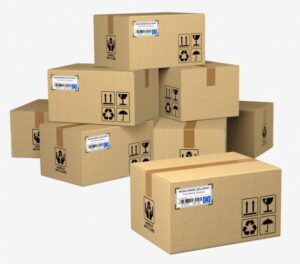In the ever-evolving world of packaging, a significant shift towards sustainability is evident, with a particular focus on “Key Sustainable Packaging Standards” that set the bar high, especially in the realm of printed boxes. These standards play a crucial role in guiding brands toward eco-conscious practices, emphasizing responsible sourcing, material usage, and end-of-life considerations to minimize environmental impact and foster a more sustainable future.
Imperative and the Role of Sustainable Packaging
Amidst growing environmental concerns, the imperative for sustainable packaging is more pronounced than ever. The emphasis on sustainability extends across all aspects of the packaging process, with printed boxes taking center stage as essential components of product presentation and brand identity. Sustainable packaging practices align with the broader goal of reducing the ecological footprint associated with custom boxes.
Sustainable Packaging Standards

Globally recognized standards, such as FSC (Forest Stewardship Council) certification and Cradle to Cradle, serve as benchmarks that guide brands in their journey towards sustainable packaging. These standards provide comprehensive guidelines for responsibly sourcing materials, ensuring that printed boxes meet stringent criteria for environmental stewardship. By adhering to these standards, brands contribute to a collective effort to address ecological challenges.
Material Selection as the Foundation
The heart of sustainable printed boxes lies in meticulous material selection. Brands prioritize responsibly sourced and recyclable materials for crafting custom boxes. Eco-friendly inks and coatings, which minimize environmental impact, are chosen to ensure that the entire lifecycle of printed boxes aligns with sustainable packaging standards. This thoughtful material selection forms the foundation of meeting and exceeding sustainability benchmarks.
Innovative Printing Techniques
In the pursuit of sustainable packaging, brands explore innovative custom printing solutions techniques for printed boxes. Water-based inks, soy-based inks, and other eco-friendly alternatives gain prominence, merging aesthetics with sustainability. These techniques not only maintain the visual appeal of custom boxes but also adhere to rigorous environmental standards, striking a balance between form and function.
Reducing the Carbon Footprint Holistically:
Sustainability in printed boxes goes beyond materials and inks, encompassing a holistic approach to reduce the carbon footprint. Brands implement measures to optimize the entire lifecycle of custom boxes, including energy-efficient manufacturing processes and streamlined transportation logistics. Packaging design is also fine-tuned to minimize environmental impact, showcasing a commitment to comprehensive sustainability practices.
Waste Reduction and the Circular Economy:
A pivotal aspect of sustainable packaging standards involves waste reduction and embracing the principles of the circular economy. Brands actively work towards closing the loop on the disposal of printed boxes by implementing recycling initiatives. Custom boxes are designed with recyclability in mind, ensuring that they seamlessly integrate into established recycling systems, thus contributing to a more circular and sustainable packaging ecosystem.
Environmental Imperative and Sustainable Packaging:
Amidst growing environmental concerns, there is an imperative for sustainable packaging. The emphasis on sustainability extends across all aspects of the packaging process, with printed boxes taking center stage as essential components of product presentation and brand identity. Sustainable packaging practices align with the broader goal of reducing the ecological footprint associated with custom boxes.
Understanding Sustainable Packaging Standards:
Globally recognized standards, such as FSC (Forest Stewardship Council) certification and Cradle to Cradle, serve as benchmarks guiding brands towards sustainable packaging. These standards provide comprehensive guidelines for responsibly sourcing materials, ensuring that printed boxes meet stringent criteria for environmental stewardship. Adhering to these standards allows brands to contribute to a collective effort to address ecological challenges.
Material Selection as the Foundation of Sustainability:
The heart of sustainable printed boxes lies in meticulous material selection. Brands prioritize responsibly sourced and recyclable materials for crafting custom boxes. Eco-friendly inks and coatings, minimizing environmental impact, are chosen to ensure that the entire lifecycle of printed boxes aligns with sustainable packaging standards. This thoughtful material selection forms the foundation of meeting and exceeding sustainability benchmarks.
Innovative Printing Techniques for Aesthetic and Environmental Harmony:
In the pursuit of sustainable packaging, brands explore innovative printing techniques for printed boxes. Water-based inks, soy-based inks, and other eco-friendly alternatives gain prominence, merging aesthetics with sustainability. These techniques not only maintain the visual appeal of custom boxes but also adhere to rigorous environmental standards, striking a balance between form and function.
Reducing the Carbon Footprint Holistically:
Sustainability in printed boxes goes beyond materials and inks, encompassing a holistic approach to reduce the carbon footprint. Brands implement measures to optimize the entire lifecycle of custom boxes, including energy-efficient manufacturing processes and streamlined transportation logistics. Packaging design is also fine-tuned to minimize environmental impact, showcasing a commitment to comprehensive sustainability practices.
Waste Reduction and the Circular Economy:
A pivotal aspect of sustainable packaging standards involves waste reduction and embracing the principles of the circular economy. Brands actively work towards closing the loop on the disposal of printed boxes by implementing recycling initiatives. Custom boxes are designed with recyclability in mind, ensuring that they seamlessly integrate into established recycling systems, thus contributing to a more circular and sustainable packaging ecosystem.
Consumer Education and Active Participation:
Adhering to sustainable packaging standards involves a commitment to consumer education. Brands use printed boxes as a platform to communicate the importance of recycling, proper disposal, and the environmental benefits of sustainable practices. Engaging and informative packaging becomes a tool for fostering awareness and encouraging active consumer participation in sustainable behaviors.
Continuous Innovation for Sustainability:
Sustainable packaging standards are dynamic and evolving, prompting brands to embrace continuous innovation. Through regular assessments, audits, and the exploration of new technologies, brands ensure that their printed boxes not only meet current standards but also adapt to future sustainability benchmarks, remaining at the forefront of eco-conscious packaging.
Global Collaboration for a Greener Future:
Recognizing the interconnected nature of sustainability, brands collaborate with industry stakeholders globally. Sharing best practices, participating in industry initiatives, and advocating for standardized sustainable packaging practices contribute to a broader impact that transcends individual efforts. This global collaboration is vital for paving the way towards a more sustainable and environmentally friendly packaging landscape.
Consumer Education and Active Participation:

Adhering to sustainable custom packaging designs standards involves a commitment to consumer education. Brands use printed boxes as a platform to communicate the importance of recycling, proper disposal, and the environmental benefits of sustainable practices. Engaging and informative packaging becomes a tool for fostering awareness and encouraging active consumer participation in sustainable behaviors.
In conclusion, the adoption of “Key Sustainable Packaging Standards” sets a high benchmark for brands, especially in the domain of printed boxes. By prioritizing responsible material choices, embracing innovative printing techniques, and actively engaging in waste reduction initiatives, brands contribute to a collective movement towards a more sustainable and environmentally friendly packaging landscape, paving the way for a greener future.


